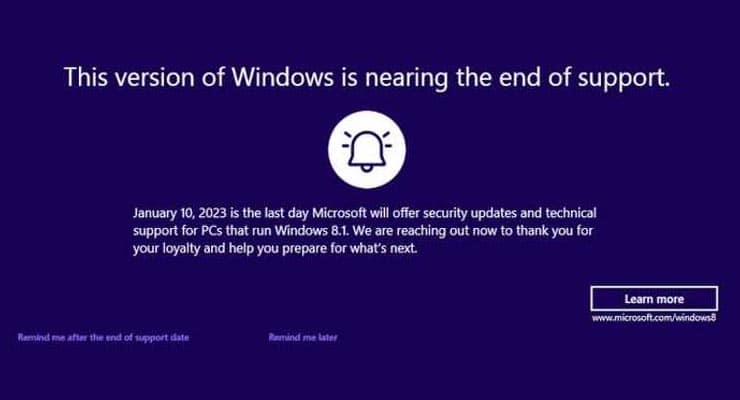Windows 8.1 users – It’s time to upgrade
The perpetual assembly line of Windows operating systems waits for no person, and the latest to drop of its edge is Windows 8.1 that has now reached the end of its extended support lifecycle and will no longer be supported after January 10th 2023.
If you can cast your mind back to 2013 – a decade ago, if you can believe that – you may remember the introduction of Windows 8.1. It was a free upgrade that reversed some of the unpopular elements of Windows 8 – such as its removal of the classic Start Button on the Taskbar as well as the pop-up Start Menu – which were designed to help Microsoft adapt its operating systems to fit into the era of touchscreen mobile devices.
At of the end of 2022, Windows 8.1 remains the 4th most popular Windows operating system used by an estimated 2.59% of machines, falling behind Windows 10, Windows 11 and Windows 7 (which worryingly ran out of support back in 2020.)
2.59% still translates to many millions of machines, however. And as always, if the operating system your computer uses falls out of extended support, we strongly recommend upgrading.
Why?
Simply because Microsoft no longer provide security updates to the operating system. This means if glaring security vulnerabilities arise – as they often do – Microsoft won’t be releasing a patch to fix them, so it’s only a matter of time before cyber-crooks will be targeting users of out-dated operating systems that exploit those vulnerabilities.
Sponsored Content. Continued below…
Security vulnerabilities can include “zero-click” vulnerabilities, that can affect users without them even doing anything other than being connected to the Internet. This makes users more vulnerable to malware and identity theft.
There are other problems with running out-dated operating systems, and that is third party companies will also stop supporting archaic versions of Windows. For instance graphics company NVIDIA stopped releasing updates for Windows 8.1, which could lead to both compatibility and security issues down the road.
January 10th 2023 is also the date when Windows 7 paid extended support expires (users had the option of paying for an additional 3 years of support) meaning there is no longer any way of keeping Windows 7 up-to-date (Windows 8.1 has no paid support option). Approximately 11% of machines still use Windows 7.
It’s time to upgrade.
Of course the immediate fix is to upgrade to ensure you stay safe and supported. Both Windows 10 and Windows 11 are still supported by Microsoft, meaning you’ll still receive security patches as well as fixes for bugs.
Continued below...
Thanks for reading, we hope this article helped, but before you leave us for greener pastures, please help us out.
We're hoping to be totally ad-free by 2025 - after all, no one likes online adverts, and all they do is get in the way and slow everything down. But of course we still have fees and costs to pay, so please, please consider becoming a Facebook supporter! It costs only 0.99p (~$1.30) a month (you can stop at any time) and ensures we can still keep posting Cybersecurity themed content to help keep our communities safe and scam-free. You can subscribe here
Remember, we're active on social media - so follow us on Facebook, Bluesky, Instagram and X
